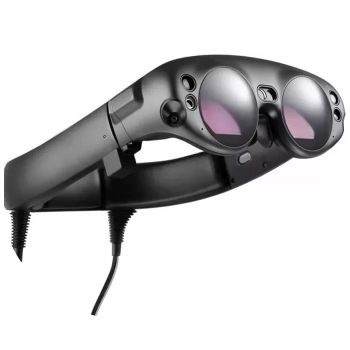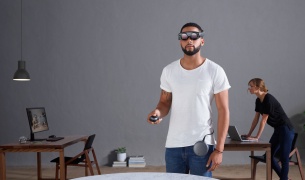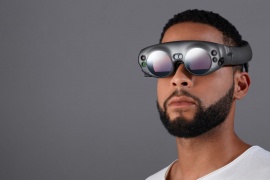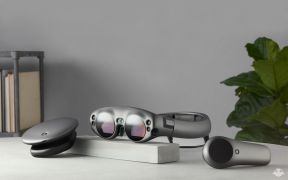Magic Leap One
| Magic Leap One | |
|---|---|

| |
| Basic Info | |
| VR/AR | Augmented Reality |
| Type | Head-mounted display |
| Subtype | Standalone AR |
| Platform | Lumin OS |
| Creator | Rony Abovitz |
| Developer | Magic Leap |
| Manufacturer | Magic Leap |
| Announcement Date | December 20, 2017 |
| Release Date | August 8, 2018 |
| Price | $2,295 USD |
| Website | https://www.magicleap.com/ |
| Versions | Magic Leap One: Creator Edition |
| Requires | None (standalone device) |
| Predecessor | None |
| Successor | Magic Leap 2 |
| System | |
| Operating System | Lumin OS |
| Chipset | NVIDIA Parker SOC (Tegra X2) |
| CPU | NVIDIA Parker SOC; 2 Denver 2.0 64-bit cores + 4 ARM Cortex A57 64-bit cores (2 A57's and 1 Denver accessible to applications) |
| GPU | NVIDIA Pascal, 256 CUDA cores |
| Storage | |
| Storage | 128 GB (95 GB available to user) |
| Memory | 8 GB RAM (approx. 4 GB available to applications) |
| SD Card Slot | No |
| Display | |
| Display | Waveguide-based display with dual focal planes |
| Peak Brightness | Approximately 200 nits |
| Resolution | 1280 x 960 per eye |
| Refresh Rate | 120 Hz |
| Image | |
| Field of View | 50° diagonal |
| Horizontal FoV | 40° |
| Vertical FoV | 30° |
| Visible FoV | 50° diagonal |
| Foveated Rendering | No |
| Optics | |
| Optics | Six-layer waveguide (2 layers each for red, green, and blue) |
| Ocularity | Binocular |
| IPD Range | Fixed IPD with software adjustment (Size 1: 60-66mm, Size 2: 66-72mm) |
| Adjustable Diopter | Yes (prescription inserts available) |
| Passthrough | Yes |
| Tracking | |
| Tracking | Inside-out tracking, 6DoF, (World, Hand, Eye) |
| Base Stations | None required |
| Eye Tracking | Yes |
| Face Tracking | No |
| Hand Tracking | Yes |
| Body Tracking | No |
| Rotational Tracking | Yes |
| Positional Tracking | Yes |
| Tracking Volume | Room-scale |
| Audio | |
| Audio | Spatial Audio built-in speakers |
| Microphone | Yes (4 microphones in headset) |
| 3.5mm Audio Jack | Yes |
| Camera | Multiple integrated sensors and at least 6 external cameras |
| Connectivity | |
| Connectivity | Bluetooth 4.2, WiFi 802.11ac/b/g/n, USB-C |
| Ports | USB-C, 3.5mm audio jack |
| WiFi | 802.11ac/b/g/n |
| Bluetooth | Bluetooth 4.2 |
| Power | Built-in rechargeable lithium-ion battery |
| Battery Life | Up to 3 hours continuous use |
| Device | |
| Weight | 316g (headset only), 415g (Lightpack), ~731g (total) |
| Material | Plastic, Metal, Fabric padding |
| Headstrap | Three-point adjustable headband with interchangeable pads |
| Haptics | Yes (controller) |
| Color | Black/Grey |
| Sensors | IMU, proximity, multiple camera sensors |
| Input | Controller with 6DoF tracking, eye tracking, head position, gestures, voice |
| Size | Two sizes available (based on IPD ranges) |
| Cable Length | Tether cable between Lightwear and Lightpack |
The Magic Leap One is an augmented reality head-mounted display developed by the tech startup Magic Leap and released in 2018. It is described by the company as the 'creator edition' of its AR headset, primarily targeting developers and creative professionals.
History and Development
Magic Leap was founded by Rony Abovitz in 2010 and operated in stealth mode for several years while developing its augmented reality technology.[1] Prior to the Magic Leap One's release, the company had raised approximately $2.6 billion in funding from investors including Google, Alibaba Group, JPMorgan, Fidelity, and others.[2]
The company generated significant buzz in the technology community through secretive development and ambitious marketing materials, some of which were later revealed to be conceptual rather than actual product captures.[3] The Magic Leap One was officially announced on December 20, 2017[4] and released to the public on August 8, 2018, at a price of $2,295 USD.[5] The system was initially only available in select US cities through AT&T, which became Magic Leap's exclusive retail partner.[6]
Hardware
The Magic Leap One mixed reality system consists of three primary hardware components: the Lightwear headset, the Lightpack computer, and the Control handheld controller.
The Lightwear Headset
The Lightwear headset features a distinctive design inspired by steampunk aesthetics. The headset includes:
- A six-layer waveguide display system (two layers each for red, green, and blue)[7]
- Resolution of 1280×960 per eye[8]
- Refresh rate of approximately 120 Hz[8]
- Field of view of 40° horizontal, 30° vertical, and 50° diagonal[9]
- Multiple integrated sensors and six external cameras for spatial tracking
- Built-in spatial audio speakers
- Four integrated microphones
- Eye tracking capabilities
- Inertial Measurement Unit (IMU) for motion sensing[10]
The headset weighs approximately 316 grams and was offered in two sizes based on interpupillary distance (IPD): Size 1 (60-66mm) and Size 2 (66-72mm).[11] Magic Leap also developed prescription lens inserts for users who required vision correction.[12]
Display Technology
The Magic Leap One uses what the company initially marketed as "Digital Lightfield Technology" but is actually a waveguide-based display system. The display functions by:
1. Using LEDs to generate the light source 2. Directing light onto a liquid crystal on silicon (LCoS) display 3. Reflecting the light to project a virtual image 4. Sending the image through the six-layer waveguide system that directs the image into the user's eyes[13]
The system features two focal planes for managing vergence-accommodation conflict, though the implementation received mixed reviews.[14] The headset blocks approximately 85% of real-world light, which was a point of criticism for some reviewers.[14]
The Lightpack Computer
The Lightpack is a disc-shaped computing unit that powers the Magic Leap One system. It features:
- NVIDIA Parker SOC (Tegra X2) with:
- 2 Denver 2.0 64-bit cores + 4 ARM Cortex A57 64-bit cores (with 2 A57's and 1 Denver accessible to applications)
- NVIDIA Pascal GPU with 256 CUDA cores[15]
- 8 GB RAM (approximately 4 GB available to applications)[15]
- 128 GB storage (with 95 GB available to users)[15]
- Built-in rechargeable lithium-ion battery with up to 3 hours of continuous use[15]
- Bluetooth 4.2, WiFi 802.11ac/b/g/n, and USB-C connectivity[15]
- Weight of approximately 415 grams[16]
The Lightpack is designed to be clipped to a belt or shoulder pad and is tethered to the headset. This design choice distributed the weight and heat generation away from the user's head, allowing for a more comfortable experience compared to headsets that contain all components in the headgear.[7]
The Controller
The Magic Leap One controller enables interaction with the mixed reality environment. It features:
- 6 degrees of freedom (6DoF) tracking
- 8-bit resolution trigger button
- Digital bumper button
- Digital home button
- Circular touchpad with LED light ring
- Haptic feedback via an LRA (Linear Resonant Actuator) device
- Built-in rechargeable lithium-ion battery with up to 7.5 hours of continuous use[17]
The controller uses a combination of electromagnetic tracking and internal sensors to determine its position in 3D space, allowing users to point at and interact with virtual objects.[18]
Technology
Visual Perception and Spatial Mapping
The Magic Leap One includes a suite of sensors that detect objects, planes, and surfaces in the surrounding environment. This technology enables the system to:
- Create a digital replica of the physical space through SLAM (Simultaneous Localization and Mapping) technology
- Allow virtual objects to interact with the physical world
- Understand the user's position within the environment
- Enable persistent placement of virtual objects in the real world
- Provide occlusion capabilities, allowing real objects to block virtual ones[19]
Persistent Objects
Through room-mapping and visual perception technologies, the Magic Leap One can store a digital representation of the physical environment. This allows virtual objects placed in a physical space to remain in their position even after the user leaves and returns to the area.[20]
Soundfield Audio
The Magic Leap One features a spatial audio system that adds intensity and distance to sound, creating a more immersive audio experience that matches the visual elements. The built-in speakers deliver audio without requiring headphones, allowing users to maintain awareness of their physical surroundings.[21]
Multiple Input Methods
The Magic Leap One accepts several input methods:
- The handheld controller for pointing and selection
- Eye tracking for gaze-based interaction
- Head position for orientation
- Gesture recognition for hand-based controls
- Voice commands for hands-free operation[22]
Software and Development
Magic Leap developed its own operating system for the Magic Leap One, called Lumin OS, based on the Android Open Source Project (AOSP).[23] The company released a Software Development Kit (SDK) alongside the hardware to allow developers to create applications for the platform.
Lumin OS
Lumin OS is the operating system that powers the Magic Leap One. It features:
- A spatial computing environment
- Support for 3D applications and content
- Integration with the device's sensor suite
- APIs for spatial mapping and environmental understanding
- A custom "Prism" UI layer for 3D application management[24]
Applications in Lumin OS can exist as windows ("Landscape Apps" or "Prisms") placed within the 3D environment or as fully immersive experiences that take over the user's view ("Immersive Apps").[24]
Development Tools
Magic Leap provided comprehensive development tools for creating content:
- Lumin SDK - The core software development kit
- Magic Kit - A suite of development tools and resources
- Unity and Unreal Engine integration plugins
- APIs for spatial mapping, eye tracking, hand tracking, and gesture recognition
- The Creator Portal website with documentation, samples, and forums[25]
Magic Leap World
Magic Leap World served as the distribution platform for applications developed for the device. Notable launch applications included:
- Helio - A web browser capable of rendering 3D web content
- Create - A spatial creation tool for drawing and manipulating 3D objects
- Tónandi - An audio-visual experience created in collaboration with Sigur Rós
- Dr. Grordbort's Invaders - A mixed reality game developed by Weta Workshop
- Angry Birds: First Person Slingshot - An AR version of the popular game[26]
Reception
The Magic Leap One received mixed reviews upon its release. Critics and reviewers highlighted both strengths and weaknesses:
Strengths
- Innovative approach to mixed reality with advanced waveguide display technology
- Comfortable design with weight distributed between the headset and Lightpack
- Precise inside-out tracking for both the environment and controller
- Strong spatial mapping capabilities
- Comprehensive developer tools for creating AR applications
- Relatively large field of view compared to competitors like the first-generation Microsoft HoloLens[27]
Weaknesses
- High price point ($2,295) limiting accessibility
- Field of view still creating a "window" effect rather than filling natural vision
- Display quality and opacity issues, with virtual objects appearing somewhat translucent
- Limited battery life of approximately 3 hours
- Inability to wear over prescription glasses (requiring separate prescription inserts)
- Waveguide display significantly darkening the real world environment
- Limited software ecosystem at launch[28]
Despite these criticisms, the Magic Leap One was acknowledged as an important step in the evolution of mixed reality hardware, providing developers with tools to explore the potential of spatial computing.
Commercial Performance
The Magic Leap One reportedly fell short of the company's initial sales expectations. Reports indicated that Magic Leap sold approximately 6,000 units in the first six months, compared to internal targets of 100,000 units.[29] This led the company to pivot its focus toward enterprise applications in late 2019, rebranding the device as Magic Leap 1 and offering an enterprise bundle.[30]
End of Life
In August 2023, Magic Leap announced that the Magic Leap One (by then renamed to Magic Leap 1) would reach its end-of-life on December 31, 2024.[31] After this date, cloud services would cease, and the devices would no longer function due to a dependency on cloud services for periodic security checks. This announcement affected all Magic Leap 1 devices, which were no longer available for purchase at that time.[31]
Legacy and Successor
The Magic Leap One was succeeded by the Magic Leap 2, which was announced in 2021 and released in September 2022. The Magic Leap 2 featured several improvements over the original, including:
- Significantly larger field of view (up to 70° diagonal)
- Lighter weight design (260g headset)
- AMD processor platform
- Dynamic dimming technology to improve visibility of virtual content
- Enterprise-focused applications and use cases
- Improved optics and display quality
- Support for OpenXR standard[32]
Magic Leap pivoted to focus primarily on enterprise and business applications with the Magic Leap 2, moving away from the consumer and creator market targeted initially with the Magic Leap One.[33]
Specifications Table
| Feature | Specification |
|---|---|
| Processor | NVIDIA Tegra X2 "Parker" SoC (2 Denver 2.0 + 4 ARM Cortex A57) |
| Graphics | NVIDIA Pascal architecture GPU (256 CUDA cores) |
| RAM | 8 GB (approx. 4 GB available to applications) |
| Storage | 128 GB (approx. 95 GB available to applications) |
| Operating System | Lumin OS (based on AOSP) |
| Display Type | Six-layer waveguide with dual focal planes |
| Resolution | 1280 x 960 per eye |
| Refresh Rate | 120 Hz |
| Field of View | 50° diagonal (40° horizontal, 30° vertical) |
| Tracking | Inside-Out 6DoF world tracking, controller tracking, hand & eye tracking |
| Audio | Integrated spatial audio speakers, 3.5mm audio jack |
| Battery Life | Up to 3 hours (Lightpack), 7.5 hours (controller) |
| Weight | Lightwear: 316g, Lightpack: 415g, Total: ~731g |
Pictures
See Also
References
- ↑ "Magic Leap - Wikipedia". https://en.wikipedia.org/wiki/Magic_Leap. Retrieved May 5, 2025.
- ↑ "Magic Leap Funding Rounds". https://www.crunchbase.com/organization/magic-leap. Retrieved May 5, 2025.
- ↑ "The fantasy of Magic Leap was too good to be true". December 8, 2016. https://www.theverge.com/2016/12/8/13894000/magic-leap-ar-microsoft-hololens-way-behind.
- ↑ "Magic Leap finally unveils augmented reality goggles, says they'll ship in 2018". December 20, 2017. https://www.theverge.com/2017/12/20/16800474/magic-leap-one-creator-edition-augmented-reality-goggles-announce.
- ↑ "Magic Leap One: Creator's Edition now available to buy in US". August 8, 2018. https://www.trustedreviews.com/news/magic-leap-one-release-date-3359749.
- ↑ "AT&T Becomes Exclusive Wireless Distributor for Magic Leap". July 11, 2018. https://about.att.com/story/2018/magic_leap_one_creator_edition.html.
- ↑ 7.0 7.1 "Magic Leap 1 augmented reality headset: A cheat sheet". March 25, 2020. https://www.techrepublic.com/article/magic-leap-1-augmented-reality-headset-a-cheat-sheet/.
- ↑ 8.0 8.1 "Magic Leap 1: Full Specification". https://vr-compare.com/headset/magicleap1. Retrieved May 5, 2025.
- ↑ "Magic Leap One Field of View Specs Finally Uncovered". July 31, 2018. https://magic-leap.reality.news/news/magic-leap-one-field-view-specs-finally-uncovered-0186278/.
- ↑ "Magic Leap One Teardown". August 23, 2018. https://www.ifixit.com/Teardown/Magic+Leap+One+Teardown/112245.
- ↑ "Sizing for Magic Leap 1". https://www.magicleap.care/hc/en-us/articles/360010588473-Sizing-for-Magic-Leap-1. Retrieved May 5, 2025.
- ↑ "Prescription Insert for Magic Leap 1". https://www.magicleap.care/hc/en-us/articles/360011140033-Prescription-Insert-for-Magic-Leap-1. Retrieved May 5, 2025.
- ↑ "Tearing Down a Magic Leap One Mixed Reality Headset Is Magical in Its Own Way". October 2, 2018. https://www.solidsmack.com/engineering/tearing-down-a-magic-leap-one-mixed-reality-headset-is-magical-in-its-own-way/.
- ↑ 14.0 14.1 "Magic Leap Review Part 1 – The Terrible View Through Diffraction Gratings". September 26, 2018. https://kguttag.com/2018/09/26/magic-leap-review-part-1-the-terrible-view-through-diffraction-gratings/.
- ↑ 15.0 15.1 15.2 15.3 15.4 "Specs - Magic Leap One: Creator's Edition". https://magic-leap.fandom.com/wiki/Specs_-_Magic_Leap_One:_Creator's_Edition. Retrieved May 5, 2025.
- ↑ "Magic Leap One - Review - Full specification". https://www.niora.net/en/p/magic_leap_one. Retrieved May 5, 2025.
- ↑ "Controller Input - Magic Leap Developer Documentation". https://developer-docs.magicleap.cloud/docs/guides/unity/input/control/controllerinput/. Retrieved May 5, 2025.
- ↑ "Here's a good explanation on how the $2,295 Magic Leap One headset works". August 24, 2018. https://www.cnbc.com/2018/08/24/how-magic-leap-works-ifixit-teardown.html.
- ↑ "Spatial Mapping Overview". https://developer-docs.magicleap.cloud/docs/guides/unity/perception/spatial-mapping/spatial-mapping-overview/. Retrieved May 5, 2025.
- ↑ "Persistence - Magic Leap Developer Documentation". https://developer-docs.magicleap.cloud/docs/guides/unity/perception/persistence/persistence/. Retrieved May 5, 2025.
- ↑ "Spatial Sound Overview". https://developer-docs.magicleap.cloud/docs/guides/unity/sound/spatial-sound/spatial-sound-overview/. Retrieved May 5, 2025.
- ↑ "Input Overview". https://developer-docs.magicleap.cloud/docs/guides/unity/input/input-overview/. Retrieved May 5, 2025.
- ↑ "Lumin OS Overview". https://developer-docs.magicleap.cloud/docs/guides/getting-started/lumin-os/overview/. Retrieved May 5, 2025.
- ↑ 24.0 24.1 "Landscape App Overview". https://developer-docs.magicleap.cloud/docs/guides/unity/app-framework/landscape-app/landscape-app-overview/. Retrieved May 5, 2025.
- ↑ "Get Started Developing". https://developer-docs.magicleap.cloud/docs/guides/getting-started/setup/get-started-developing/. Retrieved May 5, 2025.
- ↑ "Magic Leap One Launch Apps Preview". August 8, 2018. https://www.roadtovr.com/magic-leap-one-launch-apps-preview/.
- ↑ "Magic Leap One AR Review: Flawed, but with real promise". August 10, 2018. https://www.cnet.com/tech/computing/magic-leap-one-ar-review/.
- ↑ "Magic Leap's first headset is now available for $2,295". August 8, 2018. https://www.theverge.com/2018/8/8/17662040/magic-leap-one-creator-edition-preview-mixed-reality-glasses-launch.
- ↑ "Magic Leap Sells Fewer Than 6,000 Headsets in Six Months". December 6, 2019. https://www.theinformation.com/articles/magic-leap-sells-fewer-than-6-000-headsets-in-six-months.
- ↑ "Magic Leap 1 Pivots To Enterprise, ML2 Targeted For 2021". December 10, 2019. https://www.uploadvr.com/magic-leap-1-enterprise-ml2-2021/.
- ↑ 31.0 31.1 "Magic Leap 1 End of Life". https://www.magicleap.care/hc/en-us/articles/18878883445645-Magic-Leap-1-End-of-Life. Retrieved May 5, 2025.
- ↑ "Magic Leap 2". https://www.magicleap.com/magic-leap-2. Retrieved May 5, 2025.
- ↑ "Magic Leap 2 Review: A High-Spec Enterprise AR Headset". November 22, 2022. https://www.xrtoday.com/augmented-reality/magic-leap-2-review/.






